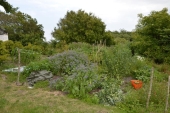

 1
1




Some places need to be wild




Standing on the shoulders of giants. Giants with dirt under their nails
 1
1




Trying to achieve self-reliance on a tiny suburban plot: http://gardenofgaladriel.blogspot.com
 1
1




Murphy was an optimist.




A build too cool to miss:Mike's GreenhouseA great example:Joseph's Garden
All the soil info you'll ever need:
Redhawk's excellent soil-building series









Long balcony garden in the green Basque Country














Some places need to be wild
 1
1




Dave de Basque wrote:A big pile of fresh grass clippings is loaded with nitrogen and will turn into a hot pile of slimy sludge in no time flat. Maybe let it start to decompose a bit, but not completely, and then put some around each plant?
And I don't think maybe 10:1 dilute urine will hurt at all actually. It's sterile when it comes out, and nature has a long time to transform it into a lot of different things before you harvest -- that's a long time off!
Just the thoughts off the top of my head.










Brad Mayeux wrote:
ive tried to work with several bags of grass clippings at once before.
i used a hard-rake to try and turn them
not fun. almost impossible, and lots of work.
if not turned often and thin, they can go anaerobic... bad microbes rain will filter down into your plants
or whatever you put them on.
best to lay them out thin, a couple inches at most. (depending on heat and moisture)
and/or mix them with ANYTHING else. the difference in size will let air in.
sand, wood-chips, gravel, hay etc...
i get 70 to 100lb of coffee grounds at a time
i throw 2 bags of slightly brown grass with a bag (80lb or so) of coffee
mix well, add 20lb of sugar sand and wet with a mix of %20 urine and a little fish.
turn daily for 2 weeks.
use as top-dress compost.
Long balcony garden in the green Basque Country
 1
1




Dave de Basque wrote:
Wow, what a recipe, Brad! That stuff must be dynamite! I am not set up too well to try that out now but I definitely plan to later. With the added advantage that coffee grounds keep snails and slugs at bay. And something better to do with grass clippings, keeping it from going anaerobic easily. Genius.
Sugar sand -- that is a derivative of the maple sugaring process? Any substitutes possible for the unfortunate sods that don't live in Vermont or Quebec?
 2
2




![Filename: IMG_20190823_093303302_HDR.jpg
Description: Red Kuri (cucurbita maxima) [Thumbnail for IMG_20190823_093303302_HDR.jpg]](/t/114384/a/86940/IMG_20190823_093303302_HDR.jpg)
"Study books and observe nature; if they do not agree, throw away the books." ~ William A. Albrecht
 1
1




Standing on the shoulders of giants. Giants with dirt under their nails














 1
1




Some places need to be wild

|
I miss the old days when I would think up a sinister scheme for world domination and you would show a little emotional support. So just look at this tiny ad:
The new gardening playing cards kickstarter is now live!
https://www.kickstarter.com/projects/paulwheaton/garden-cards
|




